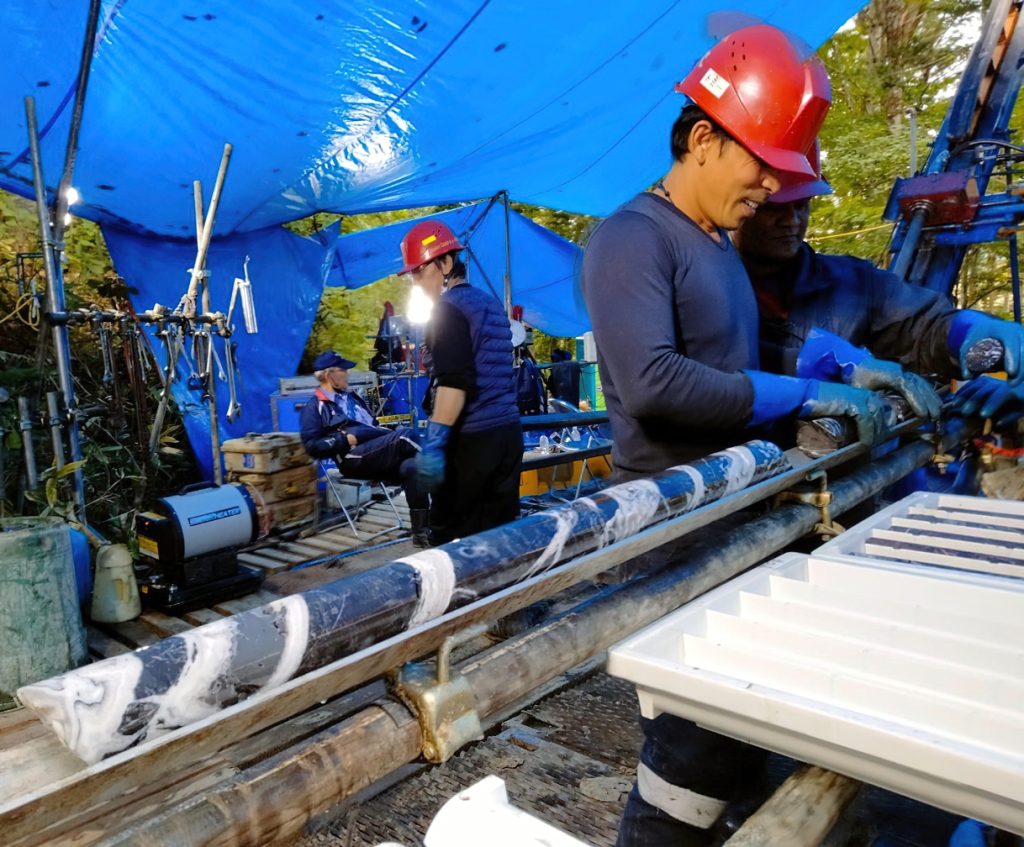Japan Gold confirms gold-bearing system with significant strike potential at Barrick Alliance Togi Project, Japan

Japan Gold Corp. [TSXV: JG; OTCQB: JGLDF] reported the results of the initial drill program at the Barrick Alliance Togi Project located on the Noto Peninsula, Honshu Island, Japan.
Drilling at the Togi Project: Akasaka target has increased confidence in extensions to a concealed and well-preserved low-sulfidation gold system, extending a kilometer from known workings and with strike potential of an additional 2 km.
“The Togi drill program has provided encouragement to the proposed exploration model at Akasaka of a concealed epithermal system extending along strike of the Mori vein workings. A syn to post-mineral basin, formed along the flanks of the Mori fault, hosts mineralized quartz vein clasts and anomalous gold in BLEG drainages along a 3-km strike corridor. It is inferred that movement on the Mori fault has buried segments of the epithermal system during its formation providing potential for concealment and preservation of an epithermal system with significant scale,” commented Mr. Andrew Rowe, Exploration Manager for the Barrick Alliance.
An initial two drill holes were completed at the Akasaka target in November 2024 targeting concealed strike extensions of the Mori vein where historical workings produced 16,500 oz of gold at an average grade of 14 g/t gold. The two drill holes located 700 metres along strike of the Mori workings and spaced 350 metres apart targeted vein extensions below concentrations of sinter scree, and quartz vein boulders and cobbles hosting gold grades up to 79.7 g/t gold.
Drilling intersected parallel alteration zones representing inferred structural extensions of the Mori fault and Mori vein hanging-wall structures concealed by up to 140 metres of syn to post-mineralization andesite and conglomerate. Alteration intersected hosts low-temperature clay assemblages and spaced narrow opaline to chalcedonic-carbonate-sulphide veins anomalous in pathfinder elements including gold. The Mori Fault zone intersected in the lower sections of both drill holes is also anomalous in gold, hosting breccia clasts of quartz-carbonate vein indicating the fault was actively moving during mineralization providing the potential for dynamic boiling levels and faulting.
The Togi drill program was fully funded by Barrick Gold Corp. [TSX: ABX; NYSE: GOLD] through its alliance with Japan Gold. A joint Japan Gold/Barrick technical committee oversees the work programs. Advancement of the Togi project will be prioritized based on results of drill programs scheduled to commence at the Hakuryu and Ebino projects in April this year.
The Togi Project comprises an area of 3,990 hectares and covers the historic Togi Goldfield which includes the Urugami and Hirochi areas of workings. Gold mineralization was discovered in the Togi area in 1896, seven separate areas of workings along a 7 km trend produced a combined 48,000 oz of gold and 180,000 oz of silver between 1910-21.
The Mori vein from the Hirochi group at the northeast end of the corridor was reported to be up to 4 m wide with production grades averaging 14 g/t gold. Records show mineralization in lower mine levels appear open to depth with average grades of 8.12 g/t gold and 56.9 g/t silver.
Gold and silver mineralization from the Urugami veins in the southwest of the corridor are hosted in stockwork vein and breccia zones. Mapped Sinter and the narrower stock-work style of quartz vein mineralization at Urugami indicate the top of a hot-spring epithermal system is preserved, supporting the potential for deeper boiling-zone vein targets in this area.
Significant mineralized intercepts included drill hole TGDD-24-001 that returned 0.50 metres of 0.2 g/t gold and 0.8 g/t silver over 325.80-326.30 metres; 0.50 metres of 0.3 g/t gold and 2.0 g/t silver over 327.80-328.30 metres; 0.65 metres of 0.2 g/t gold and 0.7 g/t silver 348.50-349.15 metres; 1.00 metre of 0.3 g/t gold and 1.6 g/t silver 537.30-538.30 metres; 0.5 metres of 0.2 g/t gold and 1.2 g/t silver 542.10-542.60; and 0.5 metres of 0.3 g/t gold and 3.5 g/t gold 543.35-543.85 metres.
Japan Gold is focused on the exploration and discovery of high-grade epithermal gold deposits across the main islands of Japan. The company holds a significant portfolio of tenements covering areas with known gold occurrences, history of mining and prospective for high-grade epithermal gold mineralization in one of the most stable and underexplored countries in the world.
Japan Gold has an alliance with Barrick Gold to jointly explore, develop and mine certain gold mineral properties and mining projects with the potential to host Tier 1 or Tier 2 gold ore bodies in Japan. Significant shareholders include Equinox Partners Investment Management LLC and Newmont Corp.
